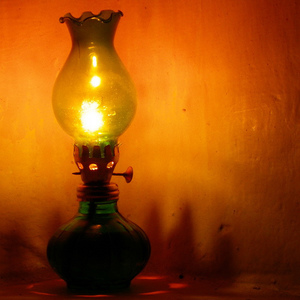How people have made artificial light over the past 4,000 years reflects the history of economic growth in the world. One economist has explored the cost of light, starting in ancient Babylonian times and ending in the 1990s. He discovered that for most of the past four millennia, light was very expensive. Then, in the past 200 years, scientific advances caused the cost of light to drop precipitously, and economies grew with a speed and intensity unknown before. Listen to hear how light became cheap and how its cost helps show how economic growth happens.
Listen to the story
AUDIE CORNISH: And now, 4,000 years of economic growth in seven minutes. This story comes, of course, from our Planet Money team. David Kestenbaum and Jacob Goldstein bring us the history of light and how the world came what it is today.
DAVID KESTENBAUM: Before you could get light at the flick of a switch, there were other options – none of them very good. Jane Brox wrote a book called “Brilliant: The Evolution Of Artificial Light.” In the tropics, she says, people would catch fireflies and make a sort of firefly lantern. And in Scotland, there was this bird called the storm petrel.
JANE BROX: Which is a very oily seabird, which they’d catch and dry and thread a wick down its throat and then light it. And then that was a lamp.
KESTENBAUM: Just carry around a dead bird?
BROX: Well, it would be on a table.
(LAUGHTER)
KESTENBAUM: These ways of making light, they were all a real hassle. It took a lot of time, a lot of effort. In short, light was really expensive.
JACOB GOLDSTEIN: Bill Nordhaus is an economist at Yale. He became obsessed with figuring out how expensive light was thousands of years ago and how it changed over time. Because light – light is this thing society has needed forever. It was a way to track progress, not just in light, but in lots of things.
KESTENBAUM: Nordhaus managed to track down some economic data from ancient Babylon. And to see how much light people were getting for their money, he set up a primitive oil lamp in his dining room and measured it with a light meter.
BILL NORDHAUS: And I would just measure it and write it down, just the way you see in the old movies, some guy in his lab coat writing down his measurements.
KESTENBAUM: Here’s the answer he got. In Babylonian times, 4,000 years ago, a day’s labor would buy very little light. You could buy enough light to illuminate a room but not for very long.
NORDHAUS: Maybe 10 minutes. It was really expensive.
KESTENBAUM: A day’s wages got you 10 minutes of light.
GOLDSTEIN: This was a world where, when the sun went down, almost everyone lived in the dark. This may sound sort of romantic but basically it was awful. The dark was something dangerous, something that trapped you. In Paris, at one point, there was actually a law that said every night, everybody has to give their keys to a magistrate, go home and lock themselves in the house.
KESTENBAUM: Economists talk a lot about productivity, how much a person can produce with a day’s labor. Back then, the answer was not much. Everything was just hard. Growing food was hard. You worked all day and you could buy almost nothing with what you earned.
The way things get better – in light and in everything – the way an economy grows, is that someone comes up with a better way to do something.
GOLDSTEIN: With light, for example, people start to use whale oil. This is very, very bad for whales. Economic growth was not all good. But whales have a lot of fat. They were these big swimming sources of fuel.
KESTENBAUM: But for thousands of years, the advances in light and in everything, else are pretty minor – things don’t change much. And light is still expensive until, Bill Nordhaus says, around 1800.
NORDHAUS: You look at the picture of what happened here, it’s economic history in a nutshell. From Babylonian times to around 1800, even though there were improvements, as best we can tell, they were very modest. And then around 1800 in the lighting – you can see it so clearly in lighting – just an enormous change in the pace of improvement.
KESTENBAUM: In the 1800s, we start to have more scientists, people devoting themselves to methodical experimentation. And around 1850, a guy in Canada comes up with something that’s not just a slightly better wick or a more efficient lamp. It’s this magical liquid. With the right techniques, you can get it from coal or oil.
GOLDSTEIN: This big breakthrough, kerosene.
Again Jane Brox.
BROX: When the first kerosene lamps came out, it was – as one historian said, it was the kind of oil people had dreamed about for centuries.
GOLDSTEIN: Kerosene burned brighter. It was cleaner. And Bill Nordhaus says it was a lot cheaper. In Babylonian times, a day’s labor got you 10 minutes of light. Now?
NORDHAUS: Kerosene, you get about five hours.
KESTENBAUM: Whoa.
NORDHAUS: Kerosene lit the world and saved the whales.
KESTENBAUM: In the 1800s, we finally get a little economic growth. People don’t have to huddle in the dark at night anymore. Streetlights become more common. People start going out more at night.
GOLDSTEIN: So we have kerosene. What’s the next big advance after that?
NORDHAUS: OK, next big advance after that is the electric lamp.
GOLDSTEIN: The big one.
NORDHAUS: Well, you might think so.
KESTENBAUM: I thought I knew the story of Thomas Edison. You know, Edison trying out all these different filaments until he gets the one that will glow for hours. But this eureka light bulb moment, it alone is not enough to get you to the world of cheap light. Edison needed something else. He needed money – lots of money because you can’t light a light bulb without electricity. He needed to build a power plant.
GOLDSTEIN: And there’s this historic moment in 1882. They’re about to throw a switch to turn on the power plant and light up part of New York City. Where is Edison when they switch it on? He’s not at the power plant. He’s at a bank.
PAUL ISRAEL: He was where he needed to be, with the people who had funded the whole thing.
KESTENBAUM: This is Paul Israel, an Edison scholar. We met him outside what back then was the bank of one of the richest guys around, JP Morgan. Morgan and a bunch of investors put up the money for the power plant. Edison was with them.
ISRAEL: So at 3 P.M on September 4th, Edison flicked on the switch here at JP Morgan’s office.
GOLDSTEIN: And what happened?
ISRAEL: It went on…
(LAUGHTER)
ISRAEL: …and as did lights all over the district. About a square mile of Lower Manhattan suddenly was lit by electricity.
GOLDSTEIN: To light a square mile of Lower Manhattan, Edison needed a whole financial system. He needed patents, a way to protect his ideas so no one would steal them. He needed a company, a way a bunch of different investors could come together and risk money – a lot of money – to build a power plant and lay wires so you could try this crazy thing, light without fire. Edison came along at a time when all this financial machinery – patents, corporations, banks – was in place.
KESTENBAUM: So the Babylonians worked a day to get 10 minutes of light.
GOLDSTEIN: Four thousand years later, in the 19th century with kerosene lamps, a day’s labor got you five hours of light.
KESTENBAUM: By the time Bill Nordhaus does his light study in the 1990s, if you work a day, how many hours of light do you get?
NORDHAUS: Maybe 20,000.
KESTENBAUM: Twenty thousand hours?
(LAUGHTER)
NORDHAUS: Twenty thousand hours, yeah. Not bad.
(LAUGHTER)
NORDHAUS: I mean, basically, you have your house lit up, you have your streets lit up – you’re saturated with light.
GOLDSTEIN: The story of light is the story of lots of things. It’s why now with a day’s wages, you can buy an evening’s worth of light and dinner, and a beer.
KESTENBAUM: And a book and a bus ticket.
GOLDSTEIN: Maybe a piece of cake and a hat.
I’m Jacob Goldstein.
KESTENBAUM: And I’m David Kestenbaum, NPR News.
 © 2014 National Public Radio, Inc. Used with the permission of NPR. All rights reserved.
© 2014 National Public Radio, Inc. Used with the permission of NPR. All rights reserved. Vocabulary
- economic growth – an increase in the amount of goods and services produced per person over a period of time
- illuminate – to light up
- magistrate – a civil officer who administers the law
- kerosene – a fuel made by distilling petroleum
- eureka moment – a moment of sudden understanding
- saturated – holding as much of something as is possible
Listening Comprehension Questions
- Why is economist Bill Nordhaus fascinated by learning about how expensive light was at different moments in time?
- How expensive was light in Babylonia? How expensive was light in 1850? In 1990?
- What was life like before people found reliable and relatively inexpensive ways to make artificial light?
- What happened around 1800 that led to light becoming less expensive?
Discussion Themes
- In your opinion, how valuable is this study? What makes you think so?
- Explain how studying how people have made artificial light is a way to measure economic growth and human progress.
Teacher’s Guide
Activate student knowledge: Discuss economic growth as a historical concept. Economic growth is the process of wealth increasing over time. When one hears about economic growth in the news, it’s usually about a country’s Gross Domestic Product—the value of goods and services a country produces. But it’s possible to look at a long history of economic growth (even if it didn’t go by that name until relatively recently). Economic historians have different ways of thinking about economic growth that has taken place over thousands of years. One model, for example, connects economic growth to the shift from economies based primarily on agriculture to those based primarily on manufacturing to those dominated by trade and service. When you consider that model, economic growth happened very slowly until about 1800. Then the speed of economic growth took off.
Introduce the story: In this audio story, you will hear about an economist who decided to track the history of economic growth by studying the cost of producing light. Listen to find out what he discovered, and what the cost of light production can show us about human progress.
Active listening supports: Choose one of the following listening organizers to support student understanding as they listen to the story.
- How Expensive Was Light? will guide student listening as they take notes on how much time and effort it took at different points in time to make artificial light. Either have students fill in the dates from listening the story or have them put 2,000 BCE (Babylonia), 1850 CE, 1990 CE in the left most column.
- The Language Identification organizer allows students to follow along and track important phrases while listening to the story.
Reflect on the story: Take time for student reflection on the audio story and discussion questions to check for understanding.
Paired Text: Use the BBC article Why the Falling Cost of Light Matters to pair with this audio story. It contains a more detailed explanation of how much work a person would need to do to make light that would last a given amount of time. Have students create an historical timeline using information from the audio story along with information from this article.


